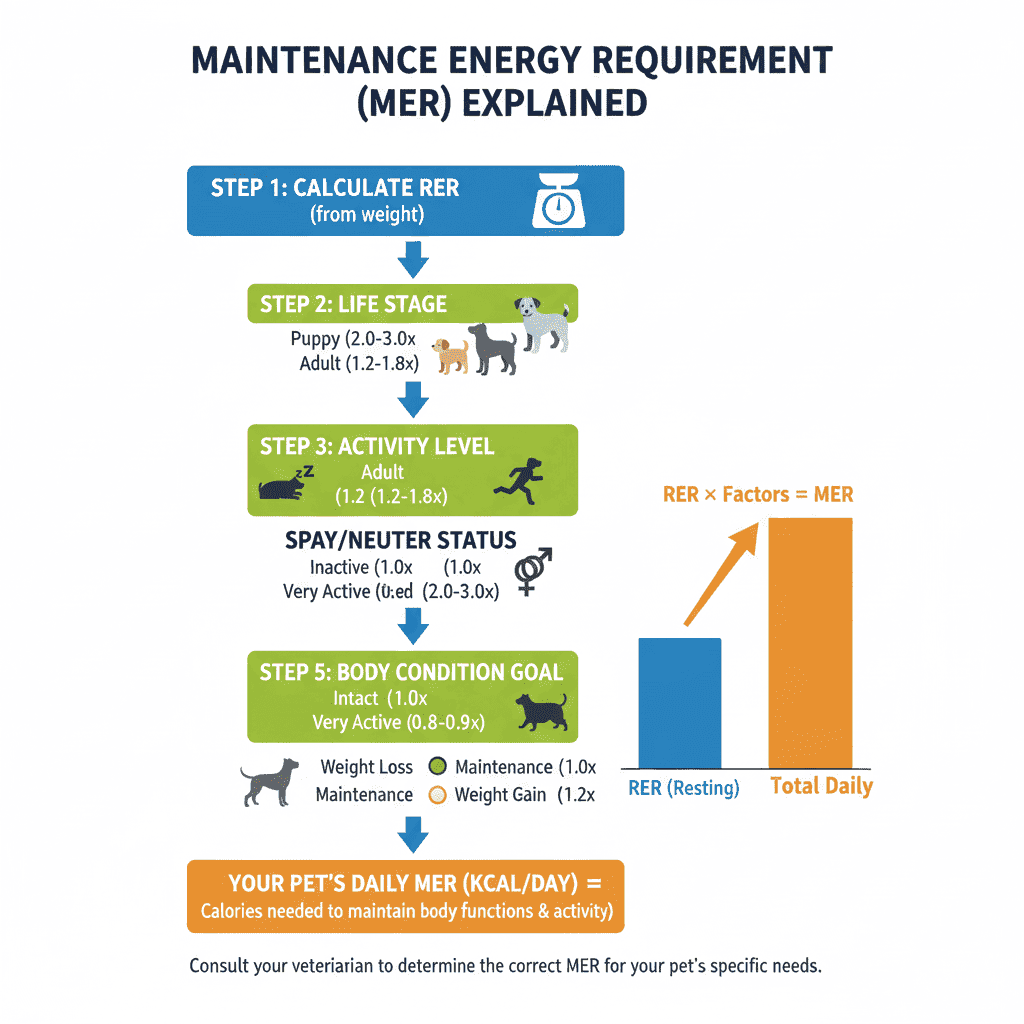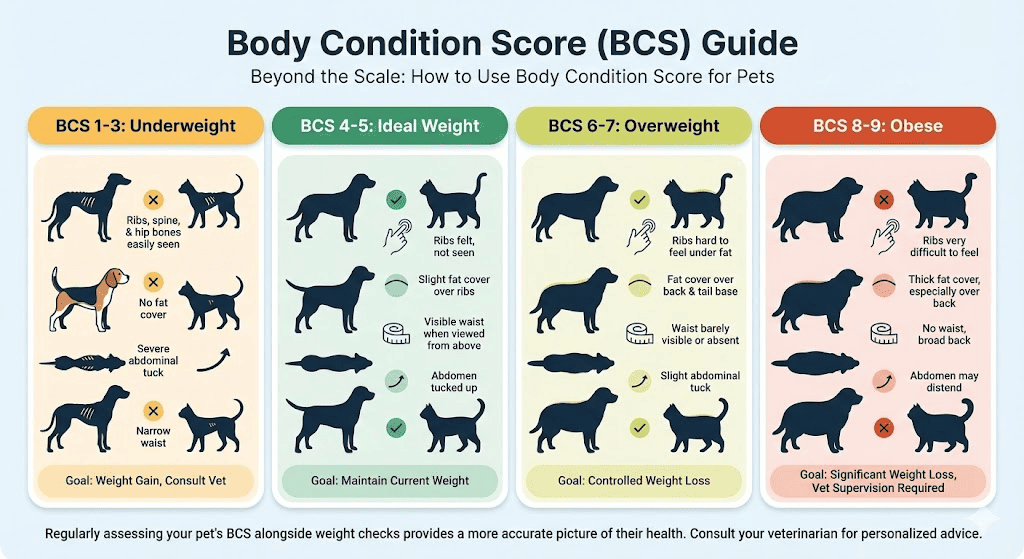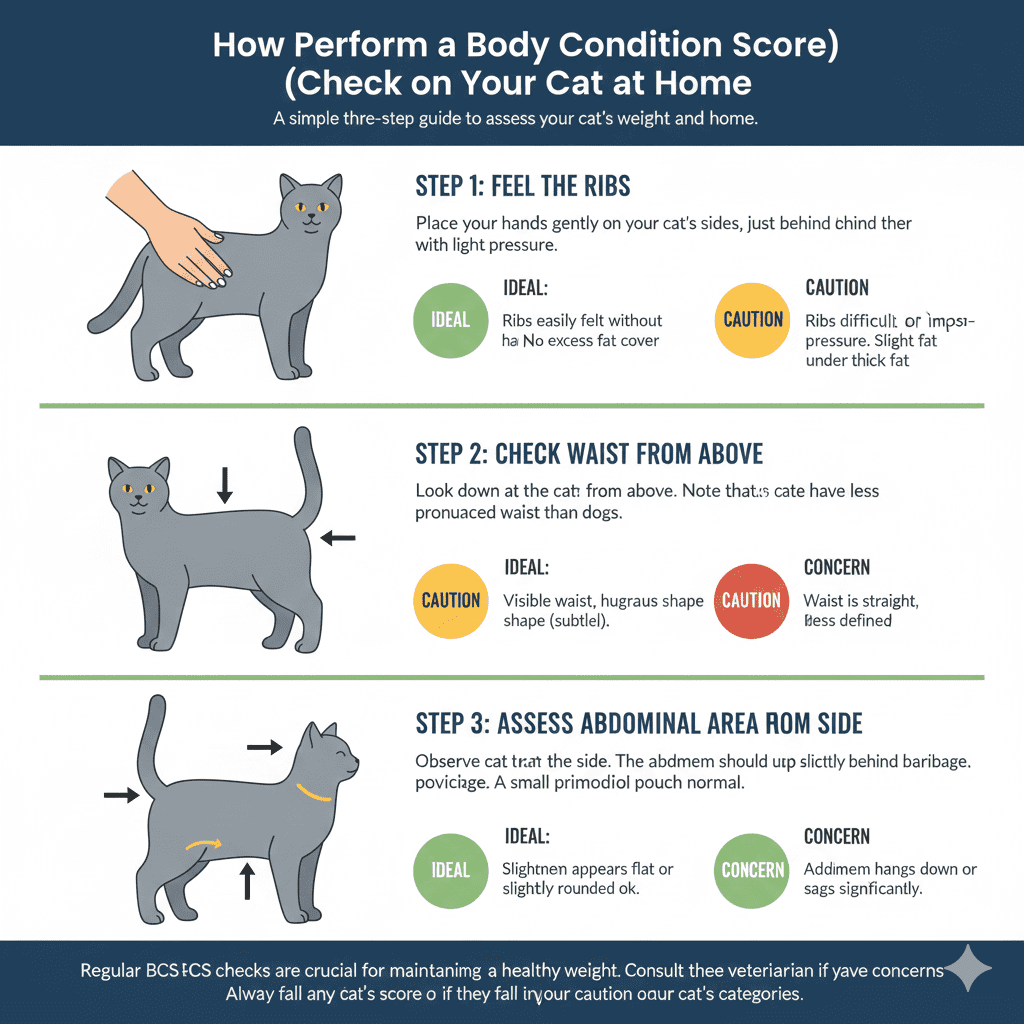You've learned about RER (Resting Energy Requirement)—the baseline calories your pet needs just to stay alive. But here's the thing: your pet doesn't just "stay alive." They play, they run, they grow, they explore, they think, they digest food, and they maintain their body temperature in varying conditions.
This is where MER, or Maintenance Energy Requirement, comes in. MER is your pet's actual daily calorie needs—the real number you need to know to feed them properly. It's RER multiplied by various factors that account for all the things your pet does beyond just existing.
Understanding MER is the difference between guessing how much to feed and knowing with scientific precision. It's the number that keeps your pet at their ideal weight, supports their activity level, and ensures they have the energy they need to thrive.
What is MER?
Maintenance Energy Requirement (MER) is the number of calories your pet needs in a 24-hour period to maintain their current body weight and condition while accounting for their normal daily activities, life stage, and individual circumstances.
Think of it this way:
- RER = Calories needed to exist (like a car idling)
- MER = Calories needed to live their actual life (like a car being driven normally)
MER accounts for:
- Physical activity: Walking, running, playing, exercise
- Life stage: Growth (puppies/kittens), maintenance (adults), or aging (seniors)
- Metabolic factors: Spay/neuter status, individual metabolism
- Body condition: Current weight status and goals
- Environmental factors: Temperature, stress
- Digestive processes: The energy needed to process food

How MER is Calculated
MER is calculated by starting with RER and then multiplying it by various factors:
MER = RER × Life Stage Factor × Activity Factor × Spay/Neuter Factor × Body Condition Factor × Other Factors
Let's break down each factor:
1. Life Stage Factor
This accounts for your pet's age and growth status:
Puppies (Dogs):
- 0-4 months: 2.0-3.0× RER (rapid growth phase)
- 4-12 months: 1.6-2.0× RER (slower growth)
- Large breed puppies: May need slightly less to prevent rapid growth
Kittens (Cats):
- 0-4 months: 2.5-3.0× RER (very rapid growth)
- 4-12 months: 1.8-2.5× RER (continued growth)
Adult Dogs:
- Neutered/Spayed: 1.4-1.6× RER (standard maintenance)
- Intact: 1.6-1.8× RER (slightly higher metabolism)
Adult Cats:
- Neutered/Spayed: 1.0-1.2× RER (cats have lower needs than dogs)
- Intact: 1.2-1.4× RER
Senior Pets:
- Dogs: 1.1-1.4× RER (reduced activity, slower metabolism)
- Cats: 1.0-1.1× RER (minimal reduction)
2. Activity Level Factor
This adjusts for how active your pet is:
Dogs:
- Inactive/Sedentary: 1.0-1.2× (couch potato, minimal exercise)
- Low Activity: 1.2-1.4× (short walks, minimal play)
- Moderate Activity: 1.4-1.6× (regular walks, some play)
- High Activity: 1.6-2.0× (long walks, regular exercise, active play)
- Very Active/Working: 2.0-3.0× (working dogs, agility, extensive exercise)
Cats:
- Inactive/Indoor Only: 1.0× (sedentary lifestyle)
- Low Activity: 1.0-1.1× (some play, mostly indoor)
- Moderate Activity: 1.1-1.2× (regular play, some activity)
- High Activity: 1.2-1.4× (very active, lots of play)
- Very Active/Outdoor: 1.4-1.6× (outdoor access, hunting behavior)
3. Spay/Neuter Factor
Sterilized pets typically have lower energy needs:
Dogs:
- Spayed/Neutered: 0.8-0.9× (20-30% reduction)
- Intact: 1.0× (no reduction)
Cats:
- Spayed/Neutered: 0.8-0.9× (20-30% reduction)
- Intact: 1.0× (no reduction)
Why this matters: Spaying and neutering reduces metabolic rate and can increase appetite. This is why sterilized pets are more prone to weight gain if fed the same amount as intact pets.
4. Body Condition Factor
This adjusts based on your pet's current weight and goals:
Weight Loss:
- Overweight (BCS 6-7): 0.8-0.9× (10-20% reduction)
- Obese (BCS 8-9): 0.7-0.8× (20-30% reduction)
Weight Maintenance:
- Ideal Weight (BCS 4-5): 1.0× (no adjustment)
Weight Gain:
- Underweight (BCS 1-3): 1.1-1.2× (10-20% increase)
5. Other Factors
Additional adjustments may be needed for:
- Pregnancy: 1.5-2.0× RER (increasing as pregnancy progresses)
- Lactation: 2.0-4.0× RER (depending on number of offspring)
- Illness/Recovery: 1.2-1.5× RER (increased needs for healing)
- Extreme temperatures: ±10-20% (hot or cold stress)
- Stress: 1.1-1.2× RER (environmental or emotional stress)
Example MER Calculations
Let's work through some real examples:
Example 1: Adult Spayed Dog, Moderate Activity, Ideal Weight
Pet: 20-pound spayed adult dog, moderate activity, BCS 4-5
-
Calculate RER:
- Weight: 20 lbs = 9.07 kg
- RER = 70 × (9.07)^0.75 = 384 calories
-
Apply factors:
- Life stage (adult spayed dog): 1.5×
- Activity (moderate): 1.5×
- Spay/neuter: Already included in life stage
- Body condition (ideal): 1.0×
-
Calculate MER:
- MER = 384 × 1.5 × 1.5 = 864 calories/day
Example 2: Adult Neutered Cat, Low Activity, Overweight
Pet: 12-pound neutered adult cat, low activity, BCS 6-7 (needs weight loss)
-
Calculate RER:
- Weight: 12 lbs = 5.44 kg
- RER = 70 × (5.44)^0.75 = 280 calories
-
Apply factors:
- Life stage (adult neutered cat): 1.1×
- Activity (low): 1.05×
- Spay/neuter: Already included
- Body condition (overweight, weight loss goal): 0.85×
-
Calculate MER:
- MER = 280 × 1.1 × 1.05 × 0.85 = 275 calories/day
Example 3: Growing Puppy, High Activity
Pet: 15-pound 3-month-old puppy, high activity
-
Calculate RER:
- Weight: 15 lbs = 6.80 kg
- RER = 70 × (6.80)^0.75 = 320 calories
-
Apply factors:
- Life stage (young puppy): 2.5×
- Activity (high): 1.8×
- Body condition (growing): 1.0×
-
Calculate MER:
- MER = 320 × 2.5 × 1.8 = 1,440 calories/day
Why MER Matters
1. Precision in Feeding
MER gives you the exact number of calories your pet needs. This eliminates guesswork and prevents both underfeeding and overfeeding.
2. Weight Management
MER is essential for:
- Maintaining ideal weight: Feed at MER for maintenance
- Weight loss: Feed 10-20% below MER
- Weight gain: Feed 10-20% above MER
3. Supporting Activity
Active pets need more calories. MER accounts for this, ensuring your pet has the energy they need for their lifestyle.
4. Life Stage Appropriateness
Puppies and kittens need more calories for growth. Seniors may need fewer. MER adjusts for these differences.
5. Preventing Obesity
Many pets become overweight because they're fed more than their MER. Understanding MER helps prevent this common problem.
Common Mistakes in MER Calculation
Mistake 1: Using RER Instead of MER
Problem: Feeding only RER to an active pet Result: Weight loss, lack of energy, health problems Solution: Always calculate MER, not just RER
Mistake 2: Ignoring Activity Level
Problem: Feeding a sedentary pet the same as an active pet Result: Weight gain in inactive pets, weight loss in active pets Solution: Accurately assess and account for activity level
Mistake 3: Not Adjusting for Spay/Neuter
Problem: Feeding a spayed pet the same as an intact pet Result: Weight gain in spayed/neutered pets Solution: Apply spay/neuter reduction factor
Mistake 4: Using Generic "Feeding Guidelines"
Problem: Relying on bag recommendations instead of calculating MER Result: Overfeeding or underfeeding Solution: Calculate MER based on your individual pet
Mistake 5: Not Recalculating
Problem: Using the same MER as your pet ages or changes activity Result: Gradual weight gain or loss Solution: Recalculate MER when circumstances change
How Our App Calculates MER
At PetMealPlanner, we use a sophisticated multi-factor calculation:
- We start with RER using your pet's current weight
- We apply life stage multipliers:
- Puppies: 2.0-3.0×
- Kittens: 2.5-3.0×
- Adults: 1.0-1.6× (depending on species and spay/neuter)
- Seniors: 1.0-1.4×
- We adjust for activity level:
- Dogs: 1.0-2.0×
- Cats: 1.0-1.6×
- We account for spay/neuter status:
- 20-30% reduction for sterilized pets
- We factor in body condition:
- Weight loss: 0.7-0.9×
- Maintenance: 1.0×
- Weight gain: 1.1-1.2×
- We calculate final MER and determine precise portions
This ensures your pet gets exactly the right amount of food for their unique situation.
When to Recalculate MER
Recalculate MER when:
- Weight changes significantly (5% or more)
- Activity level changes (more or less exercise)
- Life stage changes (puppy to adult, adult to senior)
- Spay/neuter status changes (recently sterilized)
- Body condition changes (reaching weight goals)
- Health status changes (illness, recovery)
- Environmental changes (moving, lifestyle changes)
For most pets, recalculating every 3-6 months is sufficient. For pets on weight management programs, monthly recalculation is recommended.
Monitoring and Adjusting
MER is a starting point, not a fixed number. Monitor your pet and adjust:
- If your pet is gaining weight: Reduce MER by 10-20%
- If your pet is losing weight: Increase MER by 10-20%
- If your pet maintains ideal weight: MER is correct!
Regular body condition scoring helps you catch changes early and adjust MER accordingly.
The Bottom Line
MER (Maintenance Energy Requirement) is your pet's true daily calorie needs. It's calculated by starting with RER and multiplying by factors for life stage, activity, spay/neuter status, and body condition.
Understanding MER is essential for:
- Feeding your pet the right amount
- Maintaining ideal weight
- Supporting their activity level
- Preventing obesity
- Managing weight loss or gain
MER is the number that takes your pet from "just surviving" to "thriving." It's the difference between guessing and knowing, between generic recommendations and personalized precision.
Ready to calculate your pet's MER and create a personalized meal plan? Use our pet meal planner to get started. Our system automatically calculates both RER and MER, then determines the exact portions your pet needs based on your chosen food.
For more information on the foundation of these calculations, see our article: RER Explained: Your Pet's Basic Calorie Needs.


